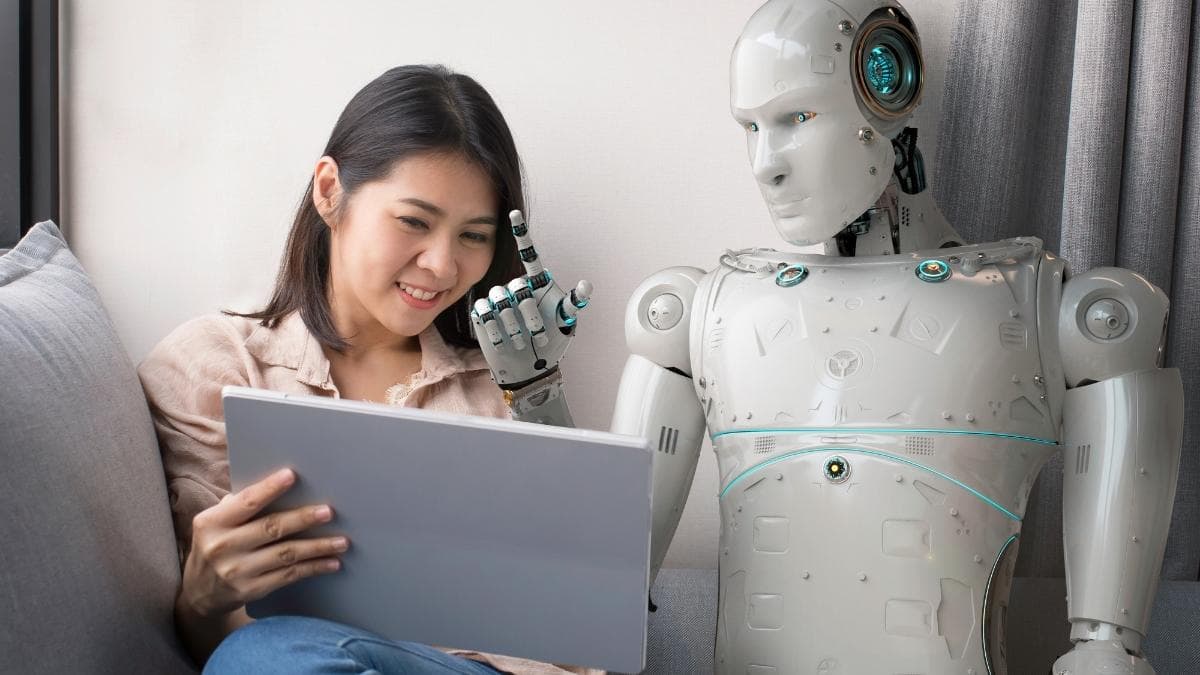Robots Helping Humans: Revolutionizing Assistance and Efficiency
By Harshitha |
Date 07-10-2024

Table of Contents
- How Do Robots Help Humans?
- Do Robots Do Jobs Without Human Help?
- How Can Robots Help Humans?
- What Can Robots Do to Help Humans?
- How Are Robots Useful to Human Beings?
- List of Robots Assisting Human Beings
- Robots Assisting People with Disabilities
- Types of Robots Assisting Humans
- Conclusion
- Frequently Asked Questions
Admissions Open for
With the integration of robots into our daily life, the ways in which we work, live, and interact with the world are being completely changed. Starting from factory floors to medical operations, robots have taken over jobs which require much efficiency, precision, and assistance that had never been imagined or conceived by people. In this article, we will analyze how robots help humans, types of robots involved, and what improvements they can offer in many facets of life.
How Do Robots Help Humans?
Robots help human beings out with everything from repetitive operations to becoming companions or assistants in hostile environments. A look into how robots will reshape human activities goes as follows:
1. Improving Productivity in Industry:
Modern robots find extensive application in industries, right from assembly, welding, and painting to packaging. Most of these operations are hugely repetitive and require a great deal of accuracy. Thus, for such work, robots are the ideal option. While humans face fatigue after a certain amount of time, robots can just go on and on, thereby increasing productivity and reducing errors.
2. Assisting Medical Professionals:
These robots provide surgery assistance, rehabilitation, and patient care in medical settings. Surgical robots, like the da Vinci Surgical System, allow for minimally invasive surgery to a degree of accuracy hard or impossible for human hands to achieve. Rehabilitation robots help patients regain lost function from injury or disease with specific physical therapy. Other robots help with routine tasks in hospitals, such as delivering medication and cleaning.
3. Helping People with Disabilities:
Robots are significant in enhancing the quality of life for those with disabilities. Assistive robots, such as exoskeletons, enable people with mobile disabilities to walk and stand and conduct activities of daily living. Communication robots assist people with speech disabilities in communicating with others, while service robots conduct household chores that improve independence in individuals with physical disabilities.
4. Better Accuracy in Research and Development:
At research labs, robots perform with precision: handling hazardous materials, conducting experiments, and gathering data. Other robots, like the Roomba, perform mundane tasks like cleaning, freeing the researchers to attend to more complex aspects of their work.
5. Enhanced Safety in Hazardous Environments:
Many robots find their application in the field of nuclear power plants, space, or disaster response where the risk factor is too high to be dealt with by human beings. They can easily access those areas, evaluate the risks involved, and execute the task while not causing harm to human life.
Do Robots Do Jobs Without Human Help?
More recently, with the development in AI and machine learning, it became achievable for robots to carry out most tasks without much human interaction. In fact, robots like self-driving cars or autonomous drones very well represent machines which can independently operate. These employ sensors, cameras, and AI algorithms for making decisions, identifying surroundings, and performing work without the need for human interaction.
1. Autonomous Vehicles:
Self-driving cars are programmed to move passengers from point to destination without human interference in the car. Such vehicles use cameras, LIDAR, GPS, and AI together to track obstacles, follow traffic rules, and continue on the roads.
2. Drones:
Application areas could also be made from drones or unmanned aerial vehicles for surveillance, mapping, and delivery services. They can also be programmed on certain routes and tasks to execute autonomously, such as keeping an eye on power lines or delivering packages to remote areas.
3. Robotic Process Automation (RPA):
Business RPA systems can carry out repetitive and rule-based tasks independently, such as data entry, invoice processing, and customer service queries, without interference from humans. These robots enhance efficiency and accuracy in administrative tasks, which in turn allows human participation to be channeled into more complex and creative areas.
How Can Robots Help Humans?
They help humans in so many ways, from physical to emotional. Herein, some of the key areas where robots are making a big difference are highlighted.
1. Physical Assistance
The use of robots takes away the need for people to be involved in tasks that may be too demanding on their bodies. In construction, for instance, robots can lift heavy materials, operate machinery, and perform repetitive tasks with minimal risk of injury.
2. Medical Aid:
Several medical robots support surgeons during their most critical operations and hence reduce the chances of further complications. They also help in processes of rehabilitation. They guide patients through exercises to regain mobility and strength.
3. Companionship:
Companion robots, such as therapeutic robots like PARO the robotic seal, are designed to provide comfort and companionship for the elderly and people with mental health disorders. These can be programmed to simulate social contact and even react to being touched in order to bring emotional comfort.
Robots are increasingly being used in educational settings to teach concepts such as programming, math, and science. They provide interactive learning experiences whereby students learn better about complex concepts with practicality.
5. Environmental Monitoring:
Robots are deployed to monitor environmental conditions, such as air and water quality, wildlife populations, and natural disasters. They can get into remote or hazardous areas, fetching so much valuable data that helps in further conservation and disaster management efforts.
What Can Robots Do to Help Humans?
New frontiers open possibilities of the capabilities that robots possess for execution of complex and varied roles. Some of the tasks that robots can perform in aiding human beings are as follows:
1. Precision Tasks:
In tasks where very high precision is required, like microelectronics assembling, performing delicate surgery, and painting intricate designs, the work can be done by robots.
2. Repetitive Tasks:
Robots perform tasks that, when done by humans repeatedly, might lead to fatigue in areas like the assembling of parts, packaging of products, sorting items among others, thus improving efficiency in manufacturing.
3. Hazardous Tasks:
The use of robots is applied to areas that are hazardous to humans, for example, handling toxic chemicals, inspection of hazardous sites, and disarming explosives.
4. Data Collection and Analysis:
Robots installed with sensors and artificial intelligence are able to gather and analyze huge amounts of data, thus providing insights for decision-making, research, and development.
5. Personal Assistance:
Robots can assist humans with daily routine tasks, such as cooking, cleaning, and handling schedules of disabled people and old-aged individuals.
How Are Robots Useful to Human Beings?
Robots help human beings in many ways: increasing our productivity, efficiency, and helping us out of difficult situations. Some of the major advantages are as follows:
1. Increased Productivity:
Robots can work day and night without breaks, which raises productivity very high in manufacturing, logistics, and farming.
2. Enhanced Precision:
Most in the fields of health and engineering, the robots work with unparalleled precision, hence reducing the chances of error, improving quality, and generally enhancing the output.
3. Improved Safety:
This is by undertaking hazardous tasks from humans, securing them from dangerous environments that may place them in great risks of getting accidents and injuries.
4. Cost-saving:
Whereas the initial investment in robotics is very high, in the long run it saves high on cost since robots do reduce labor costs, minimize waste, and raise efficiency.
5. Assistance to Vulnerable Groups:
This provides necessary assistance to the weak groups such as elderly persons and persons with disabilities as it allows them to keep their independence and improve the quality of living.
List of Robots Assisting Human Beings
There are literally countless numbers of robots developed to assist humans in one way or another. The following is the list of few of them:
1. da Vinci Surgical System:
A robotic surgical system extending a surgeon's capabilities to perform complex operations with enhanced precision during minimally invasive procedures.
2. ASIMO by Honda
A humanoid robot to assist people in everyday tasks like carrying things and giving them company in the house or at an office.
3. Roomba by iRobot:
A robotic vacuum cleaner that cleans the floor autonomously, with little or no human intervention.
4. SoftBank Robotics' Pepper:
A social robot engineered to interact with people-sometimes providing information and emotional support in retail and customer service.
5. Ekso Bionics Exoskeletons:
Wearable robotic suits donned to assist people with a variety of mobility impairments in walking, standing, and accomplishing activities of daily living.
Robots Assisting People with Disabilities
One of the most important ways in which robots help humans is by providing assistance to people with disabilities. Such robots are developed to enhance mobility, communication, and independence. This category includes:
1. Wheelchair Robots:
AI and sensor-powered robotic wheelchairs can navigate through tight spaces, avoid collisions, and even climb stairs for better mobility by the user.
2. Assistive Robots:
Robots like JACO by Kinova help those people who have limited mobility of their upper body in performing activities related to eating, drinking, and reaching objects.
3. Communication Robots:
Robots like Tobii Dynavox help people with speech impairments by allowing them to communicate through others via eye-tracking technology and speech-generating devices.
4. Service Robots:
It provides emotional support to patients suffering from various mental disorders or cognitive impairment by keeping them comfortable and relieving their loneliness.
Types of Robots Assisting Humans
There are several kinds of robots that may assist humans in one or another way. Some of the important categories include:
1. Industrial Robots:
Industrial robots are used in manufacturing and have been designed to carry out a variety of tasks, such as assembly, welding, and painting, among others, with great precision and efficiency.
2. Service Robots:
Service robots are aimed at performing housework chores, office work, and public space tasks. Included in these categories are robotic vacuum cleaners, security robots, and customer service robots.
3. Medical Robots:
This helps health professionals during surgeries, rehabilitation, and care for patients, thereby improving outcomes and efficiencies within healthcare settings.
4. Companion Robots:
Social robots designed to interact with people-for instance, providing company, emotional support, and carrying out simple tasks associated with daily life.
Conclusion
The inclusion of robots in our lives has dramatically changed the way we work, live, and interact with things. They improve productivity, thus enabling people and maintaining safety. They can also be very supportive in industries, health, and personal assistance. The development of artificial intelligence and machine learning further saw the capabilities of autonomous robots perform various tasks without humans. They are important, especially in hazardous settings where they save human life in performing dangerous activities.
The second aspect is that robots are indeed a valuable resource in the care of vulnerable groups in society, the elderly, and people with disabilities, by physically assisting them, helping to improve their means of communication, as well as providing some emotional support. As this technology is still developing, one can expect that at some point in the future, robots will play a significantly larger role in improving the quality of our lives, increasing efficiency, and furthering the boundaries of possibility. The future of human-robot collaboration is bright, promising a world where robots and humans work together harmoniously to achieve common goals.
Frequently Asked Questions
1. How do robots help humans in daily life?
Robots perform tasks for humans that involve cleaning, cooking, and managing schedules, adding greater ease and efficiency to daily life. They also support the elderly and people with disabilities, making their lives easier.
2. Is it possible for robots to work independently without human assistance?
Yes, with the aid of higher artificial intelligence and sensors, many advanced robots used these days, like autonomous cars and drones, will be able to work independently. They will be capable of understanding the events around them and can make decisions based on situations to undertake a job without the interference of humans.
3. What are the most common types of robots used in industries?
Industrial robots, for example, robotic arms, are the common types that are fitted into industries to perform several tasks like assembly, welding, and packaging. They increase productivity and accuracy in industries.
Let everyone be informed about the types of robots that help humans, and spread it around by dropping a comment that shares the blog everywhere.
CBSE Schools In Popular Cities
- CBSE Schools in Bangalore
- CBSE Schools in Mumbai
- CBSE Schools in Pune
- CBSE Schools in Hyderabad
- CBSE Schools in Chennai
- CBSE Schools in Gurgaon
- CBSE Schools in Kolkata
- CBSE Schools in Indore
- CBSE Schools in Sonipat
- CBSE Schools in Delhi
- CBSE Schools in Rohtak
- CBSE Schools in Bhopal
- CBSE Schools in Aurangabad
- CBSE Schools in Jabalpur
- CBSE Schools in Jaipur
- CBSE Schools in Jodhpur
- CBSE Schools in Nagpur
- CBSE Schools in Ahmednagar
- CBSE School In Tumkur

Call Us to know more about Orchids
Swipe Up
















